Investigating Airline Service Quality from a Business Traveller Perspective through the Integration of the Kano Model and Importance–Satisfaction Analysis
Abstract
1. Introduction
2. Review of the Literature
2.1. Service Quality and Customer Satisfaction
2.2. Airline Service Quality, Customer Satisfaction, and Loyalty
3. Research Methodology
3.1. Conceptual Framework
- Cat. 1. Must-be attributes are fundamental features for business travellers. Subsequently, when an airline fails to fulfil must-be requirements, passengers will be strongly dissatisfied, whereas the fulfilment of the attribute will not cause an increase in satisfaction.
- Cat. 2. When an airline delivers one-dimensional attributes, business traveller satisfaction will be created. When these requirements are insufficient or not fulfilled, however, dissatisfaction will be caused.
- Cat. 3. Attractive attributes will produce satisfaction when delivered, yet will not cause dissatisfaction when insufficiently or not fulfilled. These attributes can be strategically significant in assisting airlines to achieve a competitive advantage over their competition.
- Cat. 4. Indifferent attributes do not significantly contribute towards satisfaction, whether they are existent or absent in the airline product, so could theoretically be removed.
- Cat. 5. Finally, reverse attributes cause dissatisfaction when fulfilled, yet lead to satisfaction when not fulfilled. Hence, an attribute in this classification should be removed.
- Quadrant I: Customers perceive these attributes as very important. However, the performance of airlines in these attributes is regarded as below average, implying that efforts to improve should be concentrated here [13].
- Quadrant II: Attributes in this quadrant are important and customers rate their performance highly; therefore, airlines should keep up the good work [72].
- Quadrant IV: This quadrant contains attributes that have a comparatively high performance, but the attributes are of low importance to business travellers. Airline effort on these attributes is over-utilised, suggesting possible overkill; hence, airlines should consider reallocating resources somewhere else [4,13].
3.2. Data Collection Method
3.3. Design of the Instrument
4. Results and Discussion
4.1. Cluster Analysis
4.2. Kano Model Results
4.3. Importance Satisfaction Analysis
4.4. The Airline Manager’s Perspective
5. Conclusions and Managerial Implications
- Maintain performance regarding the SQAs of convenient flight schedules and frequencies, OTP, FFPs, and politeness of cabin crew;
- Concentrate on improving the responsiveness to complaints and the cleanliness of the aircraft interior and seating. Enhance lounge services for business class travellers;
- Focus on improving seat comfort in business class as well as in the long-haul premium economy and economy class. Contrarily, keep up the seat comfort in the short-haul economy class;
- Concentrate on enhancing in-flight food and beverages in business class. Maintain performance in economy class long-haul and replace a short-haul meal service focus in economy class with a buy-on-board service;
- Allocate more limited resources to in-flight entertainment and in-flight Wi-Fi. FSNCs should maintain the provision of reliable power outlets and USB ports to positively attract business travellers. Contrarily, LCCs should not overkill on highlighting the benefits of in-seat power and should allocate resources elsewhere.
Author Contributions
Funding
Data Availability Statement
Conflicts of Interest
References
- Dennet’t, C.; Ineson, E.M.; Stone, G.J.; Colgate, M. Pre-bookable services in the chartered airline industry: Increasing satisfaction through differentiation. Serv. Ind. J. 2000, 20, 82–94. [Google Scholar] [CrossRef]
- Liou, J.J.; Tzeng, G.H. A non-additive model for evaluating airline service quality. J. Air Transp. Manag. 2007, 13, 131–138. [Google Scholar] [CrossRef]
- Chen, Y.H.; Tseng, M.L.; Lin, R.J. Evaluating the customer perceptions on in-flight service quality. Afr. J. Bus. Manag. 2011, 5, 2854. [Google Scholar]
- Atalay, K.D.; Atalay, B.; Isin, F.B. FIPIA with information entropy: A new hybrid method to assess airline service quality. J. Air Transp. Manag. 2019, 76, 67–77. [Google Scholar] [CrossRef]
- Liou, J.; Hsu, C.; Yeh, W.; Lin, R. Using a modified grey relation method for improving airline service quality. Tour. Manag. 2011, 32, 1381–1388. [Google Scholar] [CrossRef]
- Kano, N.; Seraku, N.; Takahashi, F.; Tsuji, S. Attractive Quality and Must-be Quality. J. Jpn. Soc. Qual. Control 1984, 31, 147–156. [Google Scholar]
- Basfirinci, C.; Mitra, A. A cross-cultural investigation of airlines service quality through integration of Servqual and the Kano model. J. Air Transp. Manag. 2015, 42, 239–248. [Google Scholar] [CrossRef]
- Li, W.; Yu, S.; Pei, H.; Zhao, C.; Tian, B. A hybrid approach based on fuzzy AHP and 2-tuple fuzzy linguistic method for evaluation in-flight service quality. J. Air Transp. Manag. 2017, 60, 49–64. [Google Scholar] [CrossRef]
- Medina-Muñoz, D.R.; Medina-Muñoz, R.D.; Suárez-Cabrera, M.Á. Determining important attributes for assessing the attractiveness of airlines. J. Air Transp. Manag. 2018, 70, 45–56. [Google Scholar] [CrossRef]
- Chow, C.K.W. On-time performance, passenger expectations and satisfaction in the Chinese airline industry. J. Air Transp. Manag. 2015, 47, 39–47. [Google Scholar] [CrossRef]
- Waguespack, B.; Rhoades, D. Cancellations and their relationship to and impact on airline service quality. Airlines Mag. 2008, 40. [Google Scholar]
- Curtis, T.; Rhoades, D.L.; Waguespack, B.P., Jr. Satisfaction with airline service quality: Familiarity breeds contempt. Int. J. Aviat. Manag. 2012, 1, 242–256. [Google Scholar] [CrossRef]
- Chen, F.; Chang, Y. Examining airline service quality from a process perspective. J. Air Transp. Manag. 2005, 2, 79–87. [Google Scholar] [CrossRef]
- Tsafarakis, S.; Kokotas, T.; Pantouvakis, A. A multiple criteria approach for airline passenger satisfaction measurement and service quality improvement. J. Air Transp. Manag. 2018, 68, 61–75. [Google Scholar] [CrossRef]
- Statista. Business Travel Spending. 2021. Available online: https://www.statista.com/statistics/225879/countries-ranked-by-total-528business-travel-spending/ (accessed on 27 March 2023).
- Harris, J.; Uncles, M. Modeling the Repatronage Behavior of Business Airline Travelers. J. Serv. Res. 2007, 4, 297–311. [Google Scholar] [CrossRef]
- Opinion Research Corporation. Improving service quality to business travellers. Manag. Serv. Qual. Int. J. 1991, 1, 27–29. [Google Scholar] [CrossRef]
- Jiang, H.; Zhang, Y. An investigation of service quality, customer satisfaction and loyalty in China’s airline market. J. Air Transp. Manag. 2016, 57, 80–88. [Google Scholar] [CrossRef]
- Tahanisaz, S.; Shokuhyar, S. Evaluation of passenger satisfaction with service quality: A consecutive method applied to the airline industry. J. Air Transp. Manag. 2020, 83, 1–10. [Google Scholar] [CrossRef]
- Wisniewski, M. Using Servqual to Assess Customer Satisfaction with Public Sector Services. Manag. Serv. Qual. Int. J. 2001, 11, 380–386. [Google Scholar] [CrossRef]
- Parasuraman, A.; Zeithaml, V.; Berry, L. A Conceptual Model of Service Quality and Its Implications for Future Research. J. Mark. 1985, 49, 41–50. [Google Scholar] [CrossRef]
- Lewis, B.R.; Mitchell, V.W. Defining and Measuring the Quality of Customer Service. Mark. Intell. Plan. 1990, 18, 11–17. [Google Scholar] [CrossRef]
- Dotchin, J.; Oakland, J. Total Quality Management in Services: Part 3: Distinguishing Perceptions of Service Quality. Int. J. Qual. Reliab. Manag. 1994, 11, 6–28. [Google Scholar] [CrossRef]
- Woodside, A.; Frey, L.; Daly, R. Linking service quality, customer satisfaction, and behavioral intentions. J. Health Care Mark. 1989, 9, 5–17. [Google Scholar] [PubMed]
- Park, J.; Robertson, R.; Wu, C. The effect of airline SERVICE QUALITY on passengers’ behavioural intentions: A Korean case study. J. Air Transp. Manag. 2004, 10, 435–439. [Google Scholar] [CrossRef]
- Bateson, J.; Hoffman, K. Essential of Services Marketing: Concepts, Strategy, and Cases; Harcourt: San Diego, CA, USA, 2002; Volume 19, pp. 491–504. [Google Scholar]
- Prajogo, D.; McDermott, P. Examining competitive priorities and competitive advantage in service organizations using importance-performance analysis matrix. Manag. Serv. Qual. 2011, 21, 465–483. [Google Scholar] [CrossRef]
- Pina, V.; Torres, L.; Bachiller, P. Service quality in utility industries: The European telecommunications sector. Manag. Serv. Qual. 2014, 24, 2–22. [Google Scholar] [CrossRef]
- Oliver, R. Measurement and evaluation of satisfaction processes in retail settings. J. Retail. 1981, 57, 25–48. [Google Scholar]
- Hansemark, O.C.; Albinson, M. Customer satisfaction and retention: The experiences of individual with employees. Manag. Serv. Qual. 2004, 14, 40–57. [Google Scholar] [CrossRef]
- Caruana, A. The Effects of Service Quality and the Mediating Role of Customer Satisfaction. Eur. J. Mark. 2002, 36, 811–828. [Google Scholar] [CrossRef]
- Gao, Y.; Rasouli, S.; Timmermans, H.; Wang, Y. Trip stage satisfaction of public transport users: A reference-based model incorporating trip attributes, perceived service quality, psychological disposition and difference tolerance. Transp. Res. Part Policy Pract. 2018, 118, 759–775. [Google Scholar] [CrossRef]
- Sarker, R.; Kaplan, S.; Mailer, M.; Timmermans, H. Applying affective event theory to explain transit users’ reactions to service disruptions. Transp. Res. Part Policy Pract. 2019, 130, 593–605. [Google Scholar] [CrossRef]
- Chen, H.; Chao, C. Airline choice by passengers from Taiwan and China: A case study of outgoing passengers from Kaohsiung International Airport. J. Air Transp. Manag. 2015, 49, 53–63. [Google Scholar] [CrossRef]
- Gupta, H. Evaluating service quality of airline industry using hybrid best worst method and VIKOR. J. Air Transp. Manag. 2018, 68, 35–47. [Google Scholar] [CrossRef]
- Park, S.; Lee, J.S.; Nicolau, J.L. Understanding the dynamics of the quality of airline service attributes: Satisfiers and dissatisfiers. Tour. Manag. 2020, 81, 104163. [Google Scholar] [CrossRef]
- Eboli, L.; Bellizzi, M.; Mazzulla, G. A literature review of studies analysing air transport service quality from the passengers’ point of view. Transp. Econ. Rev. 2022, 34, 253–269. [Google Scholar] [CrossRef]
- Parasuraman, A.; Zeithaml, V.; Berry, L. SERVQUAL: A Multiple-Item Scale for Measuring Consumer Perceptions of Service Quality. J. Retail. 1988, 64, 12–40. [Google Scholar]
- Chang, Y.H.; Yeh, C.H. A survey analysis of service quality for domestic airlines. Eur. J. Oper. Res. 2002, 139, 166–177. [Google Scholar] [CrossRef]
- Gilbert, D.; Wong, R.K. Passenger expectations and airline services: A Hong Kong based study. Tour. Manag. 2003, 24, 519–532. [Google Scholar] [CrossRef]
- Mohamed, T.A.; AbdelFattah, Y.; Gadallah, M. Improvement of airline industry service quality. J. Manag. Eng. Integr. 2008, 1, 61. [Google Scholar]
- Tiernan, S.; Rhoades, D.L.; Waguespack, B. Airline service quality: Exploratory analysis of consumer perceptions and operational performance in the USA and EU. Manag. Serv. Qual. Int. J. 2008, 18, 212–224. [Google Scholar] [CrossRef]
- Kim, K.; Park, O.J.; Yun, S.; Yun, H. What makes tourists feel negatively about tourism destinations? Application of hybrid text mining methodology to smart destination management. Technol. Forecast. Soc. Chang. 2017, 123, 362–369. [Google Scholar] [CrossRef]
- Pangow, V.; Massie, J.; Tielung, M. Evaluating in-flight service of batik air using importance and performance analysis. J. Emba J. Ris. Ekon. Manajemen Bisnis Dan Akunt. 2017, 5, 36–48. [Google Scholar]
- Munusamy, J.; Chelliah, S. An investigation of impact of service strategy on customers’ satisfaction in the budget airline industry in Malaysia: A case study of air Asia. Contemp. Mark. Rev. 2011, 1, 1–13. [Google Scholar]
- Mikulić, J.; Prebežac, D. What drives passenger loyalty to traditional and low-cost airlines? A formative partial least squares approach. J. Air Transp. Manag. 2011, 17, 237–240. [Google Scholar] [CrossRef]
- Kurtulmuşoğlu, F.B.; Can, G.F.; Tolon, M. A voice in the skies: Listening to airline passenger preferences. J. Air Transp. Manag. 2016, 57, 130–137. [Google Scholar] [CrossRef]
- Surovitskikh, S.; Lubbe, B. Positioning of selected Middle Eastern airlines in the South African business and leisure travel environment. J. Air Transp. Manag. 2008, 14, 75–81. [Google Scholar] [CrossRef]
- Kim, H.S.; Jin, L.Y. The effects of service failure and recovery on customer satisfaction in the airline service encounter. J. Korean Oper. Res. Manag. Sci. Soc. 2004, 29, 95–116. [Google Scholar]
- Elliott, K.; Roach, D. Service quality in the air-line industry: Are carriers getting an unbiased evaluation from customers? J. Prof. Serv. Mark. 1993, 9, 71–82. [Google Scholar]
- Ali, F.; Dey, B.; Filieri, R. An assessment of service quality and resulting customer satisfaction in Pakistan International Airlines: Findings from foreigners and overseas Pakistani customers. Int. J. Qual. Reliab. Manag. 2015, 5, 486–502. [Google Scholar] [CrossRef]
- Farooq, M.; Salam, M.; Fayolle, A.; Jaafar, N.; Ayupp, K. Impact of service quality on customer satisfaction in Malaysia airlines: A PLS-SEM approach. J. Air Transp. Manag. 2018, 67, 169–180. [Google Scholar] [CrossRef]
- Carvalho, R.; Medeiros, D. Assessing quality of air transport service: A comparative analysis of two evaluation models. Curr. Issues Tour. 2021, 24, 1123–1138. [Google Scholar] [CrossRef]
- Akram, H.; Khan, A.; Javaid, A.; Talat; Rafi, S.K.; Cavaliere, L. The Elements of Service Quality and Customer Satisfaction Role in Airline Industry of Pakistan. Int. J. Manag. 2020, 9, 581–594. [Google Scholar]
- Clemes, M.; Gan, C.; Kao, T.; Choong, M. An empirical analysis of customer satisfaction in international air travel. Innov. Mark. 2008, 2, 49–62. [Google Scholar]
- Hussain, R.; Nasser, A.; Hussain, Y. Service quality and customer satisfaction of a UAE-based airline: An empirical investigation. J. Air Transp. Manag. 2015, 42, 167–175. [Google Scholar] [CrossRef]
- Vlachos, I.; Lin, Z. Drivers of airline loyalty: Evidence from the business travellers in China. Transp. Res. Part Logist. Transp. Rev. 2014, 71, 1–17. [Google Scholar] [CrossRef]
- Koklic, M.K.; Kukar-Kinney, M.; Vegelj, S. An investigation of customer satisfaction with low-cost and full-service airline companies. J. Bus. Res. 2017, 80, 188–196. [Google Scholar] [CrossRef]
- Namukasa, J. The influence of airline service quality on passenger satisfaction and loyalty: The case of Uganda airline industry. TQM J. 2013, 5, 520–532. [Google Scholar] [CrossRef]
- Kuo, Y.F.; Chen, J.Y.; Deng, W.J. IPA – Kano model: A new tool for categorising and diagnosing service quality attributes. Total Qual. Manag. 2012, 23, 731–748. [Google Scholar] [CrossRef]
- Cheng Lim, P.; Tang, N.K.; Jackson, P.M. An innovative framework for health care performance measurement. Manag. Serv. Qual. Int. J. 1999, 9, 423–433. [Google Scholar] [CrossRef]
- Pawitra, T.A.; Tan, K.C. Tourist satisfaction in Singapore–a perspective from Indonesian tourists. Manag. Serv. Qual. Int. J. 2003, 13, 399–411. [Google Scholar] [CrossRef]
- Chen, L.H.; Kuo, Y.F. Understanding e-learning service quality of a commercial bank by using Kano’s model. Total Qual. Manag. 2011, 22, 99–116. [Google Scholar] [CrossRef]
- Sahney, S. Delighting customers of management education in India: A student perspective, part I. TQM J. 2011, 23, 644–658. [Google Scholar] [CrossRef]
- Pandey, A.; Sahu, R.; Joshi, Y. Kano model application in the tourism industry: A systematic literature review. J. Qual. Assur. Hosp. Tour. 2022, 23, 1–31. [Google Scholar] [CrossRef]
- Shahin, A.; Zairi, M. Kano model: A dynamic approach for classifying and prioritizing requirements of airline travellers with three case studies on international airlines. Total Qual. Manag. 2009, 9, 1003–1028. [Google Scholar] [CrossRef]
- Oyewole, P.; Sankaran, M.; Choudhury, P. Marketing Airline Services in Malaysia: A consumer Satisfaction Orientation Approach. Innov. Mark. 2007, 1, 56–70. [Google Scholar]
- Tan, K.; Pawitra, T. Integrating SERVQUAL and Kano’s model into QFD for service excellence development. Manag. Serv. Qual. 2001, 6, 418–430. [Google Scholar] [CrossRef]
- Huang, Y.K. The effect of airline service quality on passengers’ behavioural intentions using SERVQUAL scores: A Taiwan case study. J. East. Asia Soc. Transp. Stud. 2010, 8, 2330–2343. [Google Scholar]
- Dash, G.; Paul, J. CB-SEM vs PLS-SEM methods for research in social sciences and technology forecasting. Technol. Forecast. Soc. Chang. 2021, 173, 121092. [Google Scholar] [CrossRef]
- Martilla, J.; James, J. Importance-performance analysis. J. Mark. 1977, 41, 77–79. [Google Scholar] [CrossRef]
- Wang, C. A novel approach to conduct the importance-satisfaction analysis for acquiring typical user groups in business-intelligence systems. Comput. Hum. Behav. 2016, 54, 673–681. [Google Scholar] [CrossRef]
- Bell, E.; Bryman, A.; Harley, B. Business Research Methods; Oxford University Press: Oxford, UK, 2022. [Google Scholar]
- Matzler, K.; Hinterhuber, H. How to make product development projects more successful by integrating Kano’s model of customer satisfaction into quality function deployment. Technovation 1998, 18, 25–38. [Google Scholar] [CrossRef]
- Wang, C. Incorporating customer satisfaction into the decision-making process of product configuration: A fuzzy Kano perspective. Int. J. Prod. Res. 2013, 22, 6651–6662. [Google Scholar] [CrossRef]
- Fowler, F. Survey Research Methods; Sage Publications: Schauzendeoaks, CA, USA, 2013. [Google Scholar]
- Vogt, W.; Gardner, D.; Haeffele, L. When to Use What Research Design, 1st ed.; Guildford Press: New York, NY, USA, 2012. [Google Scholar]
- De Vaus, D. Surveys in Social Research, 6th ed.; Routledge: Oxfordshire, UK, 2014. [Google Scholar]
- Južnik Rotar, L.; Kozar, M. The Use of the Kano Model to Enhance Customer Satisfaction. Organizacija 2017, 50, 339–351. [Google Scholar] [CrossRef]
- Shaw, S. Airline Marketing and Management; Ashgate Publishing Limited: Farnham, UK, 2011. [Google Scholar]
- Huse, C.; Evangelho, F. Investigating business traveller heterogeneity: Low-cost vs full-service airline users? Transp. Res. Part Logist. Transp. Rev. 2007, 43, 259–268. [Google Scholar] [CrossRef]


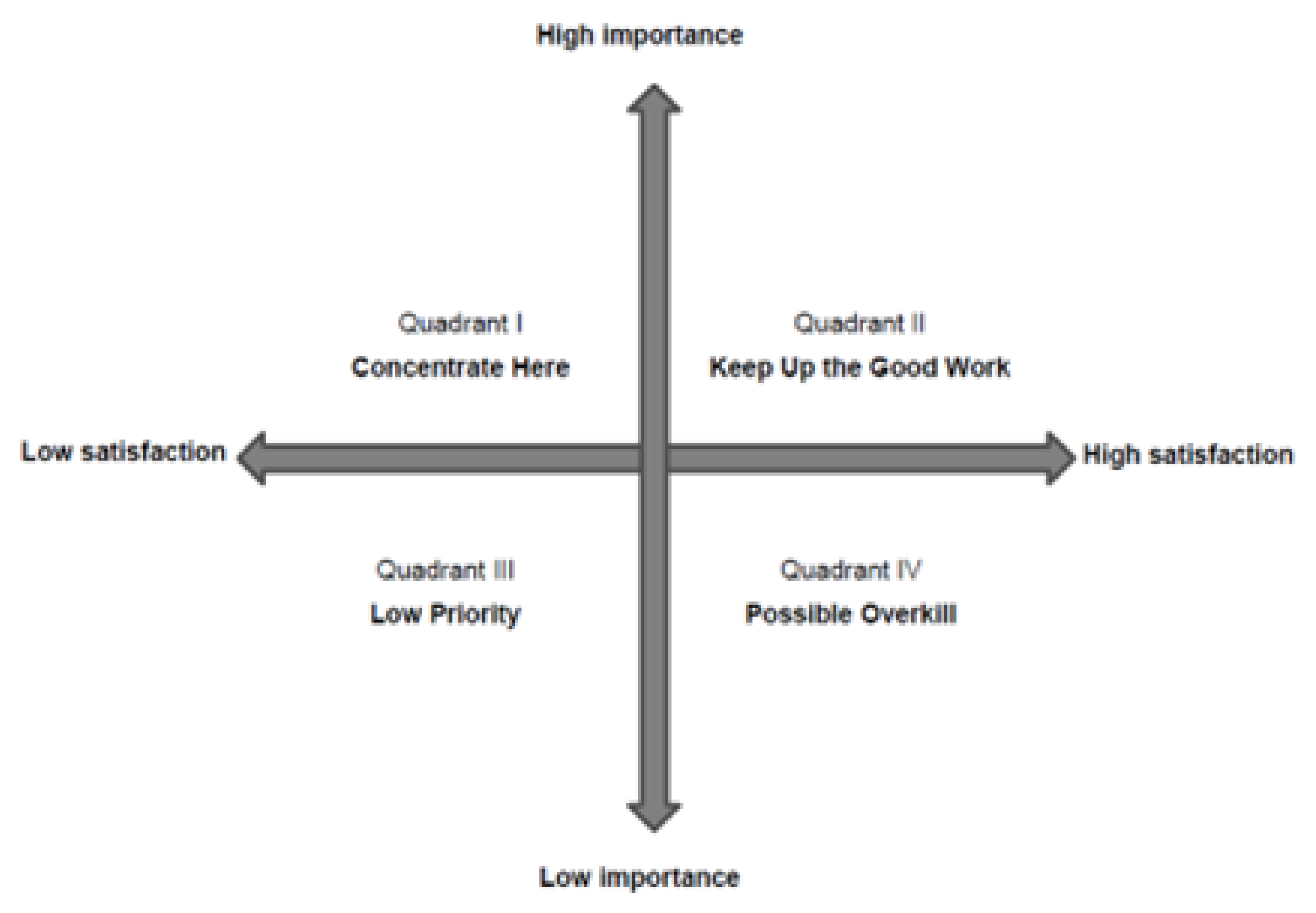
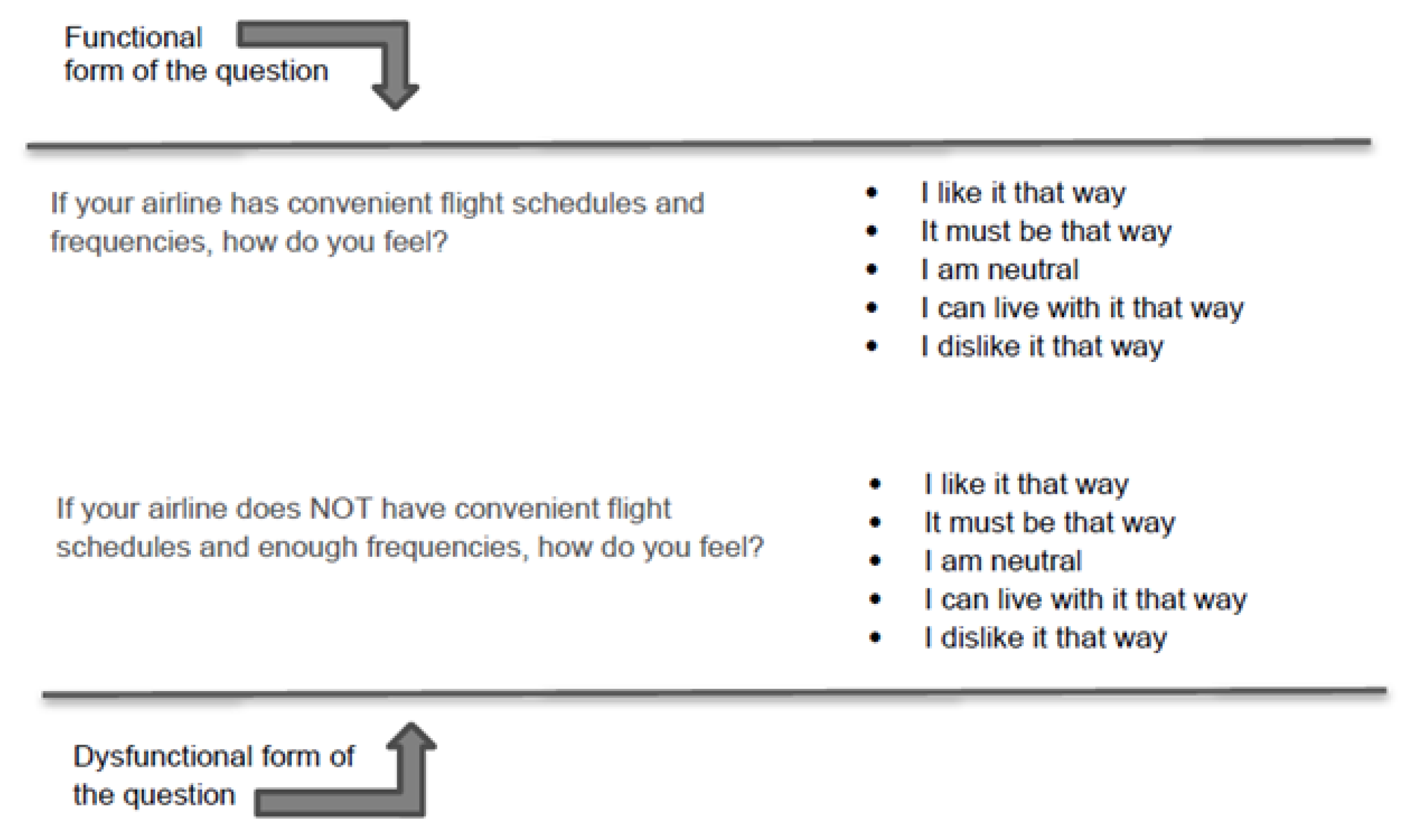

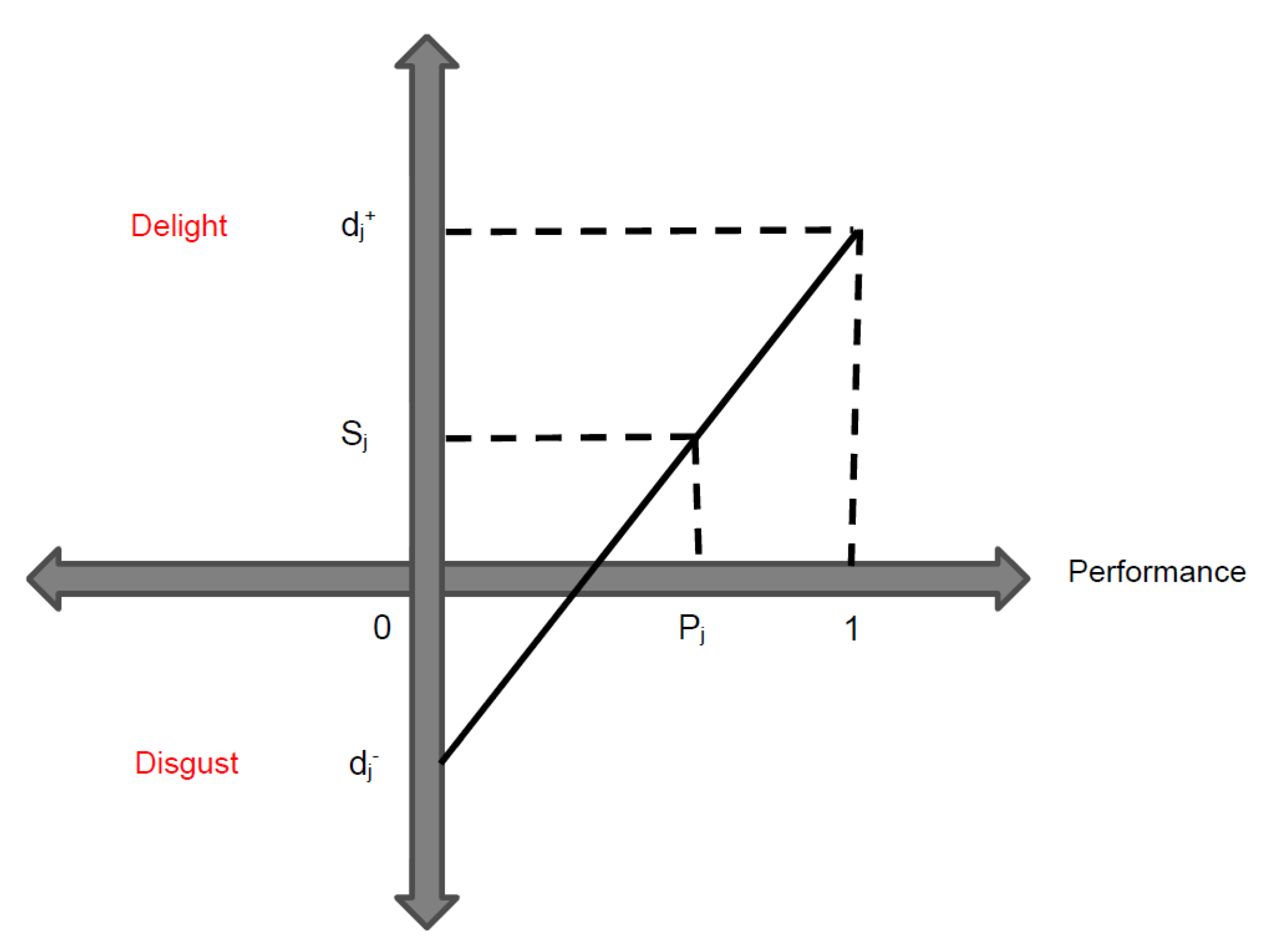
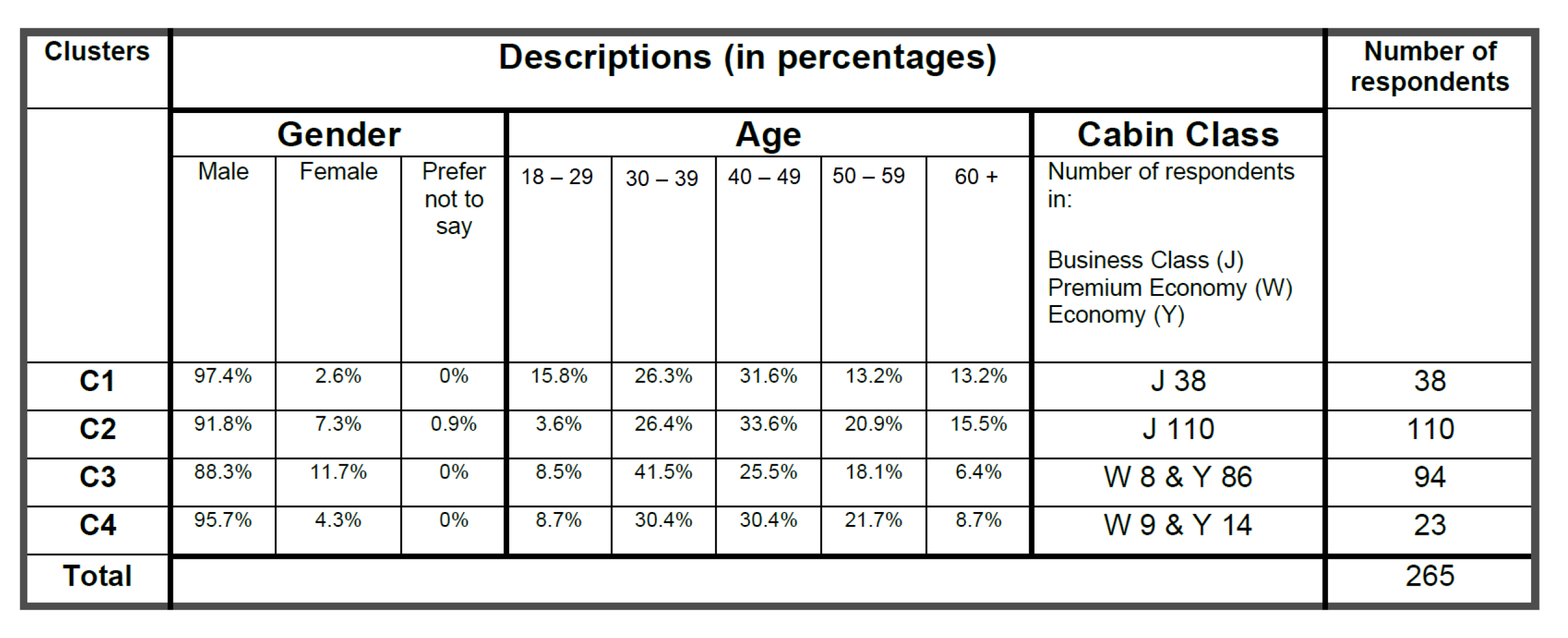
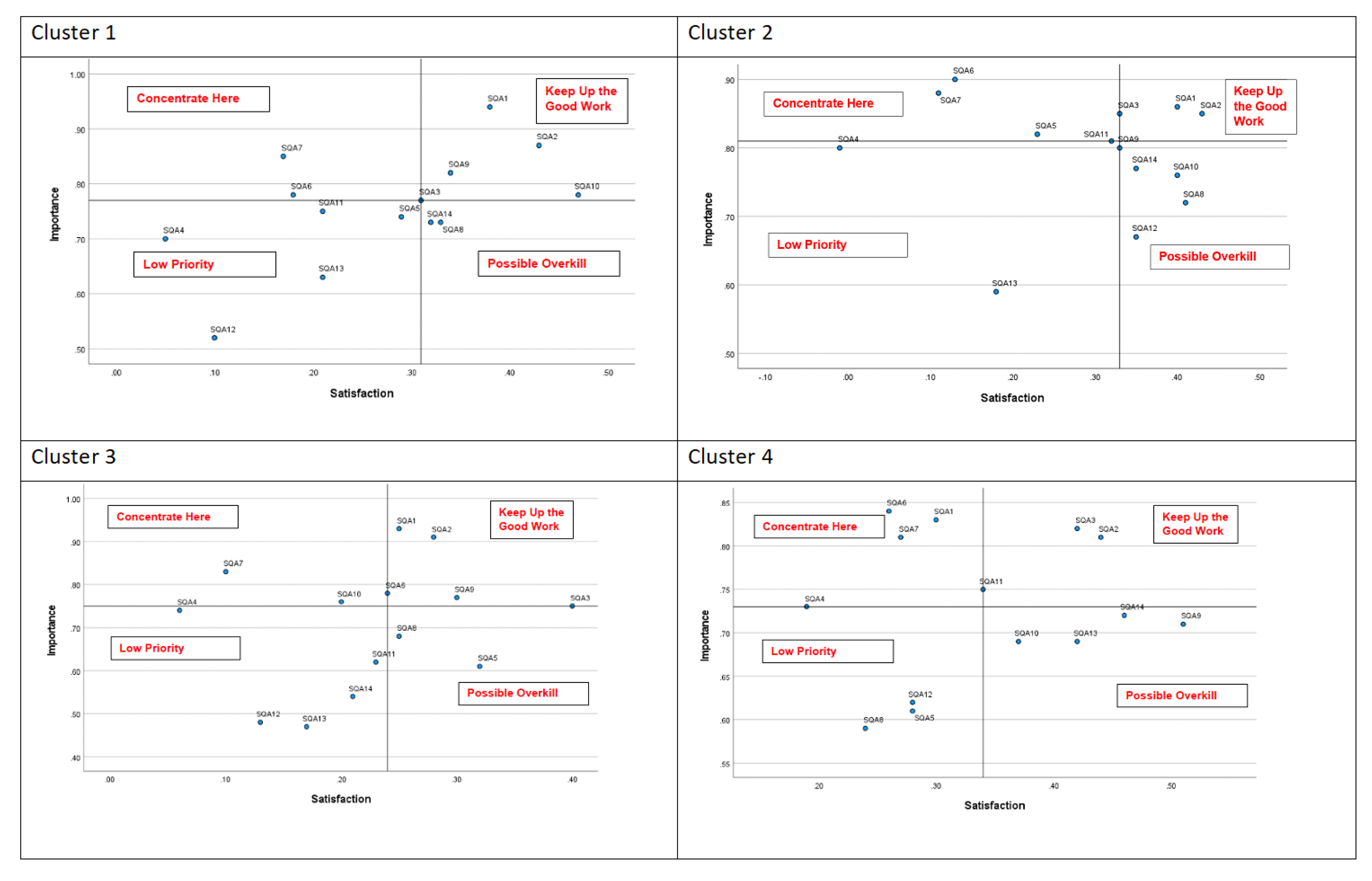
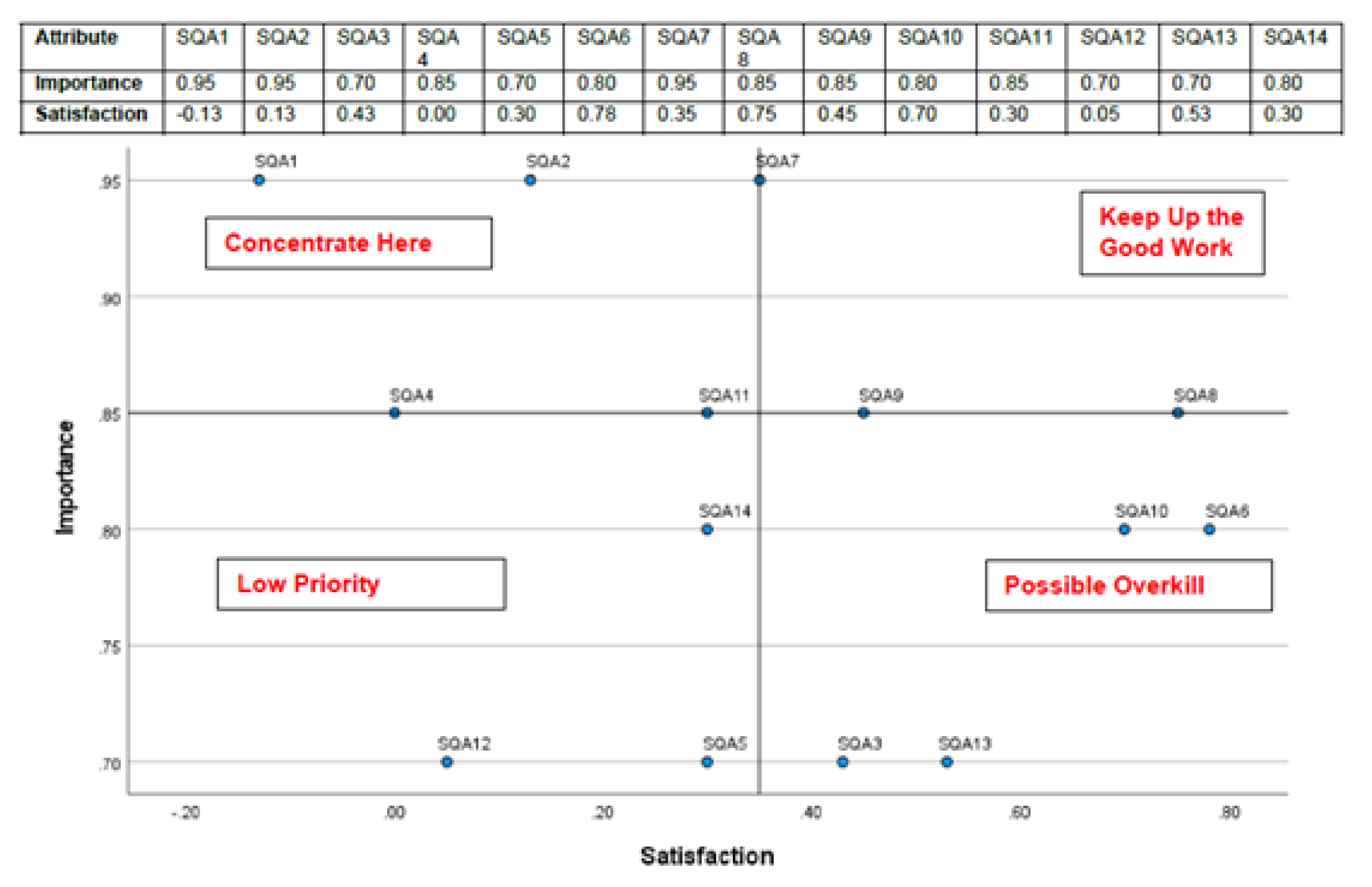
| Service Quality Attributes (SQAs) | Service Quality Dimensions (SQDs) | |
|---|---|---|
| SQA 1 | Convenient flight schedules and frequencies | Empathy |
| SQA 2 | On-time performance (OTP) | Empathy |
| SQA 3 | Frequent-flyer programme | Empathy |
| SQA 4 | Airline responsiveness to complaints | Assurance |
| SQA 5 | Airline lounge service | Reliability |
| SQA 6 | Seat comfort | Tangible |
| SQA 7 | Cleanliness of the aircraft interior and seats | Tangible |
| SQA 8 | Appearance of cabin crew | Tangible |
| SQA 9 | Politeness of cabin crew | Tangible |
| SQA 10 | Knowledge and experience of cabin crew | Assurance |
| SQA 11 | Variety and quality of in-flight meals and drinks | Assurance |
| SQA 12 | Variety and quality of in-flight entertainment | Tangible |
| SQA 13 | Access to in-flight Wi-Fi | Tangible |
| SQA 14 | Access to in-seat power | Tangible |
| Kano Category | ||||
|---|---|---|---|---|
| Service Quality Attribute | Cluster 1 | Cluster 2 | Cluster 3 | Cluster 4 |
| SQA1. Convenient flight schedules and frequencies | O | M | M | M |
| SQA2. On-time performance | O | O | O | O |
| SQA3. Frequent-flyer programme | M | M | A | M |
| SQA4. Airline responsiveness to complaints | M | M | O | O |
| SQA5. Airline lounge service | O | M | A | I |
| SQA6. Seat comfort | O | M | O | M |
| SQA7. Cleanliness of the aircraft interior and seats | M | M | M | O |
| SQA8. Appearance of cabin crew | I | O | I | I |
| SQA9. Politeness of cabin crew | O | O | M | O |
| SQA10. Knowledge and experience of cabin crew | A | A | I | A |
| SQA11. Variety and quality of in-flight meals and drinks | A | O | I | A |
| SQA12. Variety and quality of in-flight entertainment | I | I | I | I |
| SQA13. Access to Wi-Fi | I | I | I | A |
| SQA14. Access to in-seat power | A | A | I | A |
Disclaimer/Publisher’s Note: The statements, opinions and data contained in all publications are solely those of the individual author(s) and contributor(s) and not of MDPI and/or the editor(s). MDPI and/or the editor(s) disclaim responsibility for any injury to people or property resulting from any ideas, methods, instructions or products referred to in the content. |
© 2023 by the authors. Licensee MDPI, Basel, Switzerland. This article is an open access article distributed under the terms and conditions of the Creative Commons Attribution (CC BY) license (https://creativecommons.org/licenses/by/4.0/).
Share and Cite
Lippitt, P.; Itani, N.; O’Connell, J.F.; Warnock-Smith, D.; Efthymiou, M. Investigating Airline Service Quality from a Business Traveller Perspective through the Integration of the Kano Model and Importance–Satisfaction Analysis. Sustainability 2023, 15, 6578. https://doi.org/10.3390/su15086578
Lippitt P, Itani N, O’Connell JF, Warnock-Smith D, Efthymiou M. Investigating Airline Service Quality from a Business Traveller Perspective through the Integration of the Kano Model and Importance–Satisfaction Analysis. Sustainability. 2023; 15(8):6578. https://doi.org/10.3390/su15086578
Chicago/Turabian StyleLippitt, Patricia, Nadine Itani, John F. O’Connell, David Warnock-Smith, and Marina Efthymiou. 2023. "Investigating Airline Service Quality from a Business Traveller Perspective through the Integration of the Kano Model and Importance–Satisfaction Analysis" Sustainability 15, no. 8: 6578. https://doi.org/10.3390/su15086578
APA StyleLippitt, P., Itani, N., O’Connell, J. F., Warnock-Smith, D., & Efthymiou, M. (2023). Investigating Airline Service Quality from a Business Traveller Perspective through the Integration of the Kano Model and Importance–Satisfaction Analysis. Sustainability, 15(8), 6578. https://doi.org/10.3390/su15086578









